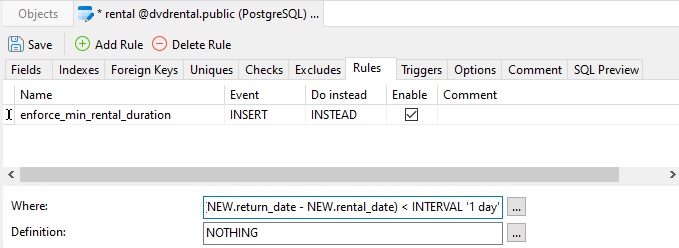PostgreSQL, a powerful open-source relational database management system, offers various features to enhance data management and manipulation. Among these features are rules, a mechanism used to control how queries and commands are processed within the database. In this article, we will explore how PostgreSQL rules work and how they differ from triggers, with a practical example using the free DVD Rental Database.
What are PostgreSQL Rules?
PostgreSQL rules provide a way to rewrite queries or commands before they are executed. They act as a set of predefined actions to be performed automatically based on certain conditions. Rules are primarily used to implement data abstraction and customization without altering the underlying schema.
Furthermore, PostgreSQL rules offer a powerful mechanism for enforcing business logic within the database itself, reducing the need for application-level constraints and ensuring consistent data manipulation across different applications or interfaces. By encapsulating complex logic within the database, rules promote data integrity and maintainability while simplifying the development process.
How do Rules Differ from Triggers?
While rules and triggers serve similar purposes in PostgreSQL, there are notable differences between the two.
- Execution Time:
- Rules: Rules are applied during query parsing, meaning they affect the query plan generation.
- Triggers: Triggers are executed after the completion of an event such as INSERT, UPDATE, or DELETE.
- Visibility:
- Rules: Rules are transparent to users executing queries. The rewritten query is visible in the query execution plan.
- Triggers: Triggers are explicitly defined on tables and are triggered by specific events.
- Granularity:
- Rules: Rules can be applied at the table level or view level, providing more flexibility in customization.
- Triggers: Triggers are bound to specific tables and cannot be applied globally.
- Complexity:
- Rules: Rules can be complex and may involve multiple actions or conditions.
- Triggers: Triggers are simpler to implement and manage as they are event-driven.
Practical Example Using the "dvdrental" Sample Database: Enforcing Data Validation
Let's explore a practical example to understand how PostgreSQL rules work in conjunction with the "dvdrental" sample database.
Suppose we want to enforce a constraint where rental durations must be at least one day. We can achieve this using a rule:
CREATE RULE enforce_min_rental_duration AS
ON INSERT TO rental
WHERE (NEW.return_date - NEW.rental_date) < INTERVAL '1 day'
DO INSTEAD NOTHING;
In Navicat we can add a rule in the "Rules" tab of the Table Designer. The "Do instead" drop-down lets us choose between "INSTEAD" and "ALSO". Meanwhile, the "Where" textbox accepts the criteria for executing the rule and the "Definition" box describes what the rule should do. Here is the complete rule definition in Navicat:

This rule ensures that any attempt to insert a rental with a duration less than one day is prevented.
Conclusion
PostgreSQL rules are a powerful tool for controlling query execution and enforcing data integrity. While similar to triggers, they offer distinct advantages in terms of execution time, visibility, granularity, and complexity. By understanding the differences between rules and triggers and leveraging their capabilities, developers can effectively customize database behavior to meet specific requirements while maintaining data integrity and security.
Interested in giving Navicat 16 For PostgreSQL a try? You can download the fully functioning application here to get a free 14 day trial!











